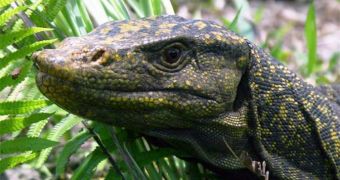While conducting a series of investigations on the densely populated Luzon Island, belonging to the Philippines, researchers managed to make an impressive finding. They discovered a new species of fruit-eating monitor lizards, which is only the third of its kind known to date. These reptiles can grow to impressive sizes, reaching up to 1.8 meters, or six feet, in length. Scientists have dubbed the new species Varanus bitatawa, and they say that it is kin to the renowned Komodo dragon, LiveScience reports.
Identifying this particular giant lizard was a surprise to researchers, mostly because the animal is very large, and also because it features spectacular colors. Generally, you may be tempted to think that a large, colored animal might not have been that hard to detect, in the 150 years since Luzon has become home to so many people. V. bitatawa features what can best be described as gold flake patterns on its back, as well as massive, curved claws on its feet. These “weapons” are an evolutionary adaptation to their living their lives in trees, the researchers hypothesize.
“I am most impressed that such a large, conspicuous, brightly colored species of monitor lizard escaped the notice of biologists for the past 150 years,” University of Kansas field herpetologist and researcher Rafe Brown says of the recent discovery. Over the past couple of decades, the discovery of large species has become increasingly scarce, as humans have finally developed the tools to venture in some of our planet's most desolate ecosystems. One possible explanation for why this species of monitor lizards was not identified could be the fact that it liked its privacy.
It was discovered in the northern forests of the island, and researchers say that the animals’ behavior would seem to indicate they are not particularly fond of crossing large swaths of open land. This may explain how they have managed to remain hidden for such a long time. “At the same time, we are humbled because the species is not really new – it is only new to us as Western scientists. In fact, resident indigenous communities – the Agta and Ilongot tribes – have known about it for many generations. If only scientists had listened to them earlier!” Brown adds further on. Details on the monitor lizard appear in the March 7 online issue of the esteemed scientific publication Biology Letters.

 14 DAY TRIAL //
14 DAY TRIAL //